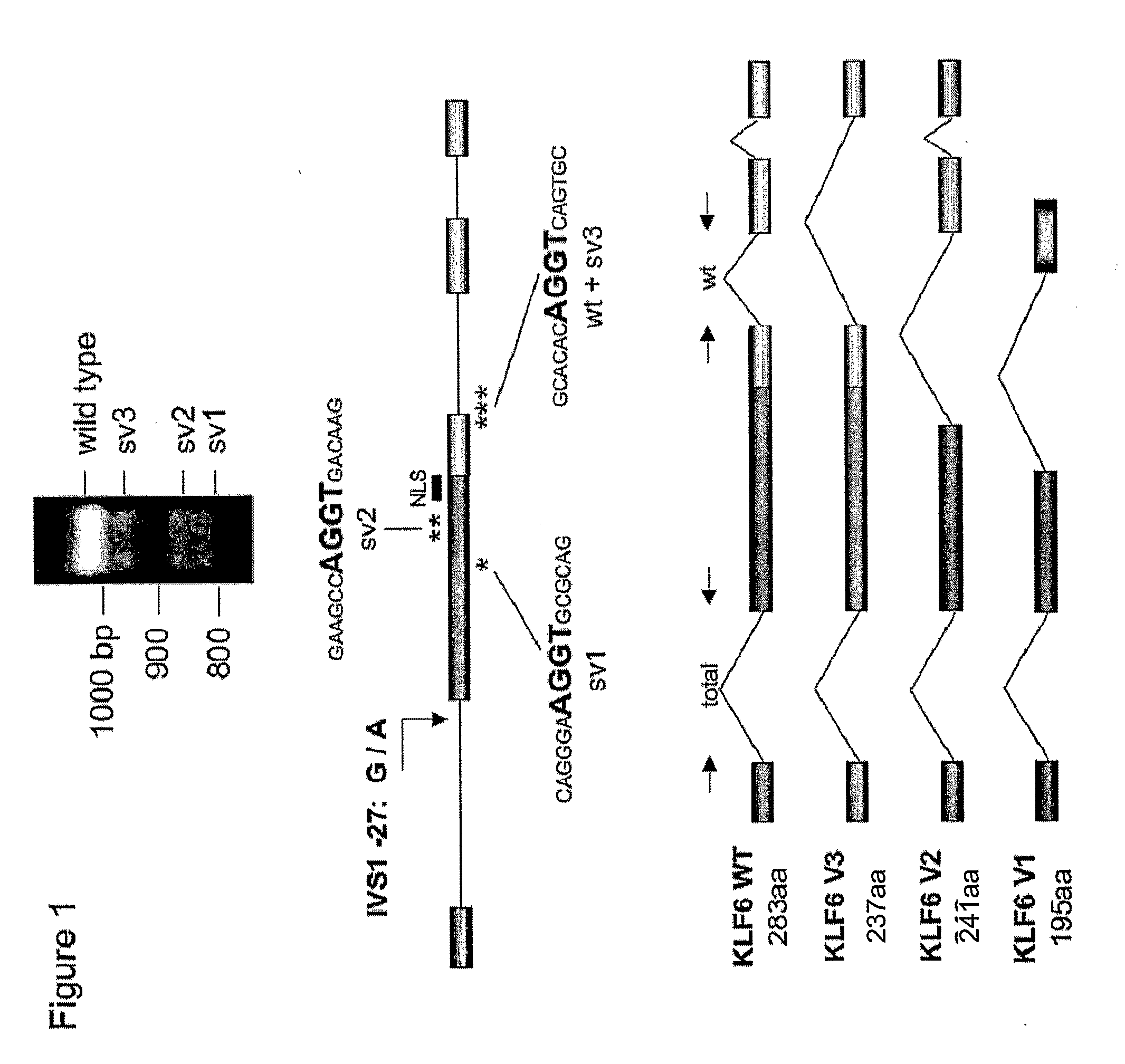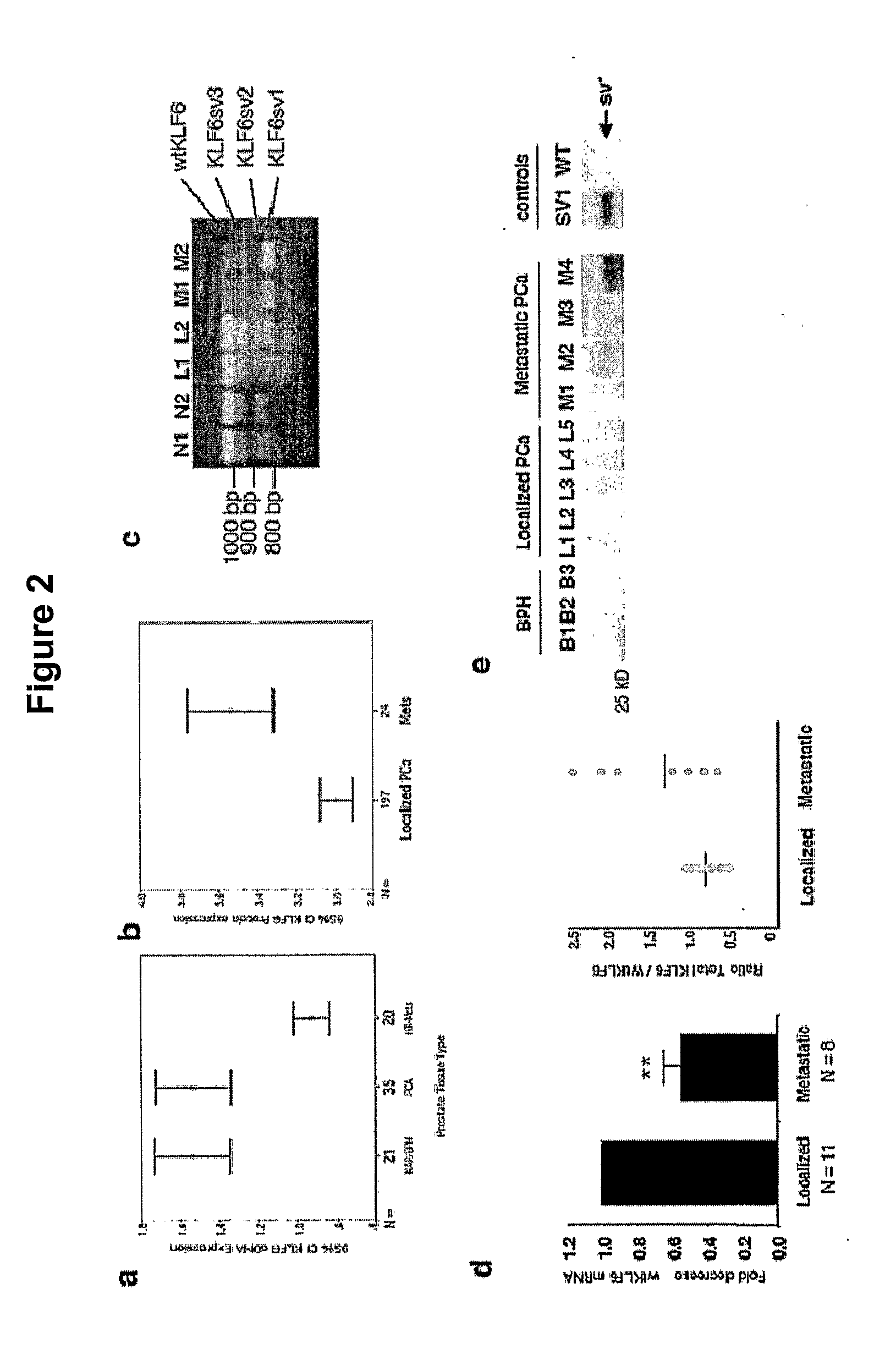Klf6 alternative splice forms and a germline klf6 DNA polymorphism associated with increased cancer risk
a klf6 dna polymorphism and alternative splice technology, applied in the field of klf6 alternative splice forms and germline klf6 dna polymorphism associated with increased cancer risk, can solve the problems of uncontrollable growth, cancer diagnosis in individuals remains a difficult task, and current cancer treatment such as surgery, chemotherapy and radiation, to achieve the effect of preventing cancer metastasis
- Summary
- Abstract
- Description
- Claims
- Application Information
AI Technical Summary
Problems solved by technology
Method used
Image
Examples
example 1
Detection of KLF6 Splice Variants in Transfected Cells
[0171]This example describes the detection of splice variants of the KLF6 gene, produced from a common polymorphism, IVSΔA.
Materials and Methods
[0172]Sequence Analysis. All sequencing was performed either on an ABI Prism 3730 or 3700 automated DNA analyzer and sequence data was analyzed using the Sequencher 4.1 program (Gene Codes Corporation) or Phred / Phrap / Consed (University of Washington). Genomic DNA was amplified to generate a 171 bp amplicon using the following wtKLF6 specific primers: ΔATG Fwd: 5′-CGG GCA GCA ATG TTA TCT GTC CTT C-3′ (SEQ ID NO: 7) and ΔATG Rev: 5′-TTC TGA GGC TGA AAC ATA GCA GGG-3′ (SEQ ID NO: 8). The PCR product was then either sequenced per standard protocols or digested with BsaAI (New England Biolabs) using the manufacturer's recommendations and resultant products were gel electrophoresed on a 1.5% TAE gel for 1 hour at 80V and then visualized by ethidium bromide staining.
[0173]wtKLF6 minigene constru...
example 2
KLF6 Splicing in Human Cancers
[0176]This example describes the detection of KLF6 splice variants in prostate, ovarian and hepatocellular cancer, as well as in benign, and metastatic cells.
Materials and Methods
[0177]Sequence and Genotype Analysis. Genomic DNA was extracted from peripheral blood samples as previously described (Carpten et al., Nat Genet. 2002; 30: 181-4; Wang et al., Cancer Res. 2001; 61: 6494-9; Stanford et al., Cancer Epidemiol Biomarkers Prev. 1999; 8: 881-6). DNA from 142 probands from the JHU Familial Prostate Cancer Registry was analyzed by direct sequence analysis of the second exon and intron / exon boundaries using wtKLF6 specific primer combinations as previously described (Narla et al., Science. 2001; 294: 2563-6). PCR products were directly sequenced in both orientations after purification (Qiagen, QIAquick PCR purification kit). All sequencing was performed as indicated in Example 1. In addition, all JHU genotypes were reconfirmed at a second institutional ...
example 3
Comparison to wtKLF6 and Correlation as a Method of Diagnosis / Prognosis
[0199]This example describes the relationship between levels of wtKLF6 and KLF6 splice variants. A ratio of these two factors is present in tissues throughout tumor progression. Therefore, this ratio is useful as both a diagnosis of tumor status, as well as a method for determination of disease progression.
Materials and Methods
[0200]RNA and qRT-PCR analysis. See Example 2 for relevant methodology.
Sequence and Genotype Analysis. See Examples 1 and 2 for relevant methodology.
Results and Discussion
Correlation of KLF6 Splicing and Tumor Grade
[0201]Prostate tumor samples were haplotyped and the splicing ratios determined for all nine of the 15 originally analyzed samples for which Gleason scores were available The IVSΔA allele was associated with a 30% increase in splice ratio in tumors graded 3+3 (* p<0.01) (G / G n=3; G / A n=2) and a 40% increase in the higher grade 4+4 (** p<0.001) (G / G n=2; G / A n=2). Taken together, ...
PUM
| Property | Measurement | Unit |
|---|---|---|
| Tm | aaaaa | aaaaa |
| Tm | aaaaa | aaaaa |
| Tm | aaaaa | aaaaa |
Abstract
Description
Claims
Application Information
 Login to View More
Login to View More - R&D
- Intellectual Property
- Life Sciences
- Materials
- Tech Scout
- Unparalleled Data Quality
- Higher Quality Content
- 60% Fewer Hallucinations
Browse by: Latest US Patents, China's latest patents, Technical Efficacy Thesaurus, Application Domain, Technology Topic, Popular Technical Reports.
© 2025 PatSnap. All rights reserved.Legal|Privacy policy|Modern Slavery Act Transparency Statement|Sitemap|About US| Contact US: help@patsnap.com



